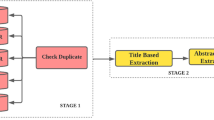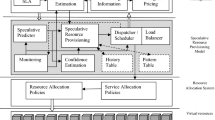Abstract
Resource planning is becoming an increasingly important and timely problem for cloud users. As more Web services are moved to the cloud, minimizing network usage is often a key driver of cost control. Most existing approaches focus on resources such as CPU, memory, and disk I/O. In particular, CPU receives the most attention from researchers, but the bandwidth is somehow neglected. It is challenging to predict the network throughput of modern Web services, due to the factors of diverse and complex response, evolving Web services, and complex network transportation. In this paper, we propose a methodology of what-if analysis, named Log2Sim, to plan the bandwidth resource of Web services. Log2Sim uses a lightweight workload model to describe user behavior, an automated mining approach to obtain characteristics of workloads and responses from massive Web logs, and traffic-aware simulations to predict the impact on the bandwidth consumption and the response time in changing contexts. We use a real-life Web system and a classic benchmark to evaluate Log2Sim in multiple scenarios. The evaluation result shows that Log2Sim has good performance in the prediction of bandwidth consumption. The average relative error is 2% for the benchmark and 8% for the real-life system. As for the response time, Log2Sim cannot produce accurate predictions for every single service request, but the simulation results always show similar trends on average response time with the increase of workloads in different changing contexts. It can provide sufficient information for the system administrator in proactive bandwidth planning.
Similar content being viewed by others
References
Goncalves M, Cunha M, Mendonca N C, Sampaio A. Performance inference: a novel approach for planning the capacity of IaaS cloud applications. In: Proceedings of the 8th IEEE International Conference on Cloud Computing. 2015, 813–820
Wolke A, Bichler M, Setzer T. Planning vs. dynamic control: resource allocation in corporate clouds. IEEE Transactions on Cloud Computing, 2016, 4(3): 322–335
Amiri M, Mohammad-Khanli L. Survey on prediction models of applications for resources provisioning in cloud. Journal of Network and Computer Applications, 2017, 82: 93–113
Hu J, Huang L, Huang J, Sun T, Ouyang Y. What-if model construction and validation of Web systems based on log mining. In: Proceedings of the 24th Asia-Pacific Software Engineering Conference. 2017, 505–512
Guzek M, Bouvry P, Talbi E G. A survey of evolutionary computation for resource management of processing in cloud computing. IEEE Computational Intelligence Magazine, 2015, 10(2): 53–67
Kim K I, Wang W, Humphrey M. PICS: a public iaas cloud simulator. In: Proceedings of IEEE International Conference on Cloud Computing. 2015, 211–220
Hu J, Huang L, Sun T, Xu Y, Gong X. Log2Sim: automating what-if modeling and prediction for bandwidth management of cloud hosted Web services. In: Proceedings of IEEE International Conference on Web Services. 2018, 99–106
Ciancone A, Filieri A, Drago M L, Mirandola R, Grassi U. KlaperSuite: an integrated model-driven environment for reliability and performance analysis of component-based systems. In: Proceedings of the 49th International Conference on Objects, Models, Components, Patterns. 2011, 99–114
Rathfelder C, Kounev S, Evans D. Capacity planning forevent-based systems using automated performance predictions. In: Proceedings of the 26th IEEE/ACM International Conference on Automated Software Engineering. 2011, 352–361
Garcia D F, Garcia J. TPC-W e-commerce benchmark evaluation. Computer, 2003, 36(2): 42–48
Hu J, Huang L, Fan Y, Tong L, Hu W. Bandwidth planning of Web services in changing contexts based on network simulation. In: Proceedings of IEEE International Conference on Web Services. 2019, 242–246
Bahga A, Madisetti V K. Synthetic workload generation for cloud computing applications. Journal of Software Engineering and Applications, 2011, 4(7): 396
Abbors F, Truscan D, Ahmad T. Mining Web server logs for creating workload models. In: Proceedings of the 9th International Joint Conference on Software Technologies. 2015, 131–150
Vogele C, van Hoorn A, Schulz E, Hasselbring W, Krcmar H. WESSBAS: extraction of probabilistic workload specifications for load testing and performance prediction-a model-driven approach for session-based application systems. Software and Systems Modeling, 2018, 17(2): 443–447
Amza C, Cecchet E, Chanda A, Cox A L, Elnikety S, Gil R, et al. Specification and implementation of dynamic Web site benchmarks. In: Proceedings of IEEE International Workshop on Workload Characterization. 2002
Oi H, Niboshi S. Workload analysis of SPECjEnterprise2010. In: Proceedings of IEEE International Symposium on Parallel and Distributed Processing with Applications. 2012
Dan P, Moore A W. X-means: extending k-means with efficient estimation of the number of clusters. In: Proceedings of the 17th International Conference on Machine Learning. 2000, 727–734
Becker S, Koziolek H, Reussner R. The Palladio component model for model-driven performance prediction. Journal of Systems and Software, 2009, 82(1): 3–22
Varga A. Using the OMNeT++ discrete event simulation system in education. IEEE Transactions on Education, 1999, 42(4): 372
Koziolek H. Performance evaluation of component-based software systems: a survey. Performance Evaluation, 2010, 67(8): 634–658
Desnoyers P, Wood T, Shenoy P, Singh R, Patil S, Vin H. Modellus: automated modeling of complex internet data center applications. ACM Transactions on the Web, 2012, 6(2): 1–29
Caban D, Walkowiak T. Prediction of the performance of Web based systems. In: Zamojski W, Sugier J, eds. Dependability Problems of Complex Information Systems. Springer International Publishing, 2015
Hao W, Zhengxin Z, Jiacheng L, Kun Y, Ching-Hsien H. Multiple attributes QoS prediction via deep neural model with contexts. IEEE Transactions on Services Computing, 2018
Tariq M, Zeitoun A, Ualancius V, Feamster H, Ammar M. Answering what-if deployment and configuration questions with wise. IEEE/ACM Transactions on Networking, 2013, 21(1): 1–13
Zhang L, Zhang B, Pahl C, Xu L, Zhu Z. Personalized quality prediction for dynamic service management based on invocation patterns. In: Proceedings of International Conference on Service-Oriented Computing. 2013, 84–98
Viswanath P, Pinkesh R. I-DBSCAN: a fast hybrid density based clustering method. In: Proceedings of International Conference on Pattern Recognition. 2006, 912–915
Li Y, Liu B. A normalized Levenshtein distance metric. IEEE Transactions on Pattern Analysis and Machine Intelligence, 2007, 29(6): 1091–1095
Cardwell N, Savage S, Anderson T. Modeling TCP latency. In: Proceedings of the 19th Joint Conference of the IEEE Computer and Communications Societies. 2002
Cain H W, Rajwar R, Marden M, Lipasti M H. An architectural evaluation of Java TPC-W. In: Proceedings of the 17th International Symposium on High-Performance Computer Architecture. 2001
Shyam G K, Manvi S S. Virtual resource prediction in cloud environment: a Bayesian approach. Journal of Network and Computer Applications, 2016, 65: 144–154
Wang H, Wang L, Yu Q, Zheng Z, Lyu M, Bouguettaya A. Online reliability prediction via motifs-based dynamic bayesian networks forservice-oriented systems. IEEE Transactions on Software Engineering, 2016, 43(6): 556–579
Stewart C, Shen K. Performance modeling and system management for multi-component online services. In: Proceedings of the International Symposium on Networked Systems Design and Implementation. 2005
Alam F M, Mohan S, Fowler J W, Gopalakrishnan M. A discrete event simulation tool for performance management of Web-based application systems. Journal of Simulation, 2012, 6(1): 21–32
Koziolek H, Schlich B, Becker S, Hauck M. Performance and reliability prediction for evolving service-oriented software systems. Empirical Software Engineering, 2013, 18(4): 746–790
Zheng W, Bianchini R, Janakiraman G J, Santos J R, Turner Y. JustRunIt: experiment-based management of virtualized data centers. In: Proceedings of USENIX Annual Technical Conference. 2009
Jayasinghe D, Swint G, Malkowski S, Li J, Wang Q, et al. Expertus: a generator approach to automate performance testing in iaas clouds. In: Proceedings of the 5th IEEE International Conference on Cloud Computing. 2012, 73–80
Verdickt T, Dhoedt B, De Turck F, Demeester P. Hybrid performance modeling approach for network intensive distributed software. In: Proceedings of the 6th International Workshop on Software and Performance. 2007, 189–200
Jung G, Mukherjee T, Kunde S, Kim H, Sharma N, Goetz F. CloudAdvisor: a recommendation-as-a-service platform for cloud configuration and pricing. In: Proceedings of the 9th IEEE World Congress on Services. 2013, 456–463
Li A, Yang X, Kandula S, Zhan M. CloudCmp: comparing public cloud providers. In: Proceedings of the 2010 ACM SIGCOMM Conference on Internet Measurement. 2010
Zheng Z, Ma H, Lyu M R, King I. Qos-aware Web service recommendation by collaborative filtering. IEEE Transactions on Services Computing, 2011, 4(2): 140–152
Yu C, Huang L. A Web service qos prediction approach based on time-and-location-aware collaborative filtering. Service Oriented Computing and Applications, 2016, 10(2): 135–149
Lo W, Yin J, Li Y, Wu Z. Efficient Web service QoS prediction using local neighborhood matrix factorization. Engineering Applications of Artificial Intelligence, 2015, 38: 14–23
Wu H, Yue K, Li B, Zhang B, Hsu C H. Collaborative QoS prediction with context-sensitive matrix factorization. Future Generation Computer Systems, 2018, 82: 669–678
Acknowledgements
This work was supported by the National Key Research and Development Program of China (2018YFB1003302) and the National Natural Science Foundation of China (Grant No. 61472241).
Author information
Authors and Affiliations
Corresponding author
Additional information
Jianpeng Hu received his BS and MS degrees from East China University of Science and Technology, Donghua University, China in 2003 and 2006, respectively. He is an associate professor of computer science in the School of Electronic and Electrical Engineering, Shanghai University of Engineering Science, China. He has just received his PhD degree in computer science from Shanghai Jiao Tong University, China. His research interests include software engineering, modeling and simulation, software architecture, and system of systems.
Linpeng Huang received his MS and a PhD degree in computer science from Shanghai Jiao Tong University, China in 1989 and 1992, respectively. He is a professor of computer science in the department of computer science and engineering, Shanghai Jiao Tong University, China. His research interests lie in the area of distributed systems, data-driven software development, big data analysis, and in-memory computing.
Tianqi Sun received the BS degree in electronic information engineering from Anhui University of Finance and Economics, China in 2017. He is currently working toward the MS degree with the School of Electronic and Electrical Engineering at the Shanghai University of Engineering Science, China. His research interests include service computing, data mining and machine learning.
Ying Fan received her BS degrees in the School of Physics and Electrical Engineering, Anyang Normal University, China. Also, she is currently working toward the MS degree in the School of Electronic and Electrical Engineering, Shanghai University of Engineering Science, China. Her research interests include data mining and cloud computing.
Wenqiang Hu is now studying for an MS degree at Shanghai University of Engineering Science, China. He received his BS degree in South-Central Minzu University, China. His current research interests include positioning in wireless cellular network and distributed computing.
Hao Zhong received his PhD degree from Peking University, China in 2009. His PhD dissertation was nominated for the distinguished PhD dissertation award of China Computer Federation. After graduation, he worked as an assistant professor at Institute of Software, Chinese Academy of Sciences, and was promoted as an associate professor in 2012. From 2013 to 2014, he was a visiting scholar at the University of California, USA. Since 2014, he had become an associate professor at Shanghai Jiao Tong University. His research interest is the area of software engineering, with an emphasis on empirical software engineering and mining software repositories. He served on the program committees of several reputable conferences such as ICSE, ESEC/FSE, ASE, OOPSLA, ICSME, MSR, and COMPSAC. He is a recipient of ACM SIGSOFT Distinguished Paper Award 2009, the best paper award of ASE 2009, and the best paper award of APSEC 2008.
Electronic Supplementary Material
Rights and permissions
About this article
Cite this article
Hu, J., Huang, L., Sun, T. et al. Proactive planning of bandwidth resource using simulation-based what-if predictions for Web services in the cloud. Front. Comput. Sci. 15, 151201 (2021). https://doi.org/10.1007/s11704-019-9117-x
Received:
Accepted:
Published:
DOI: https://doi.org/10.1007/s11704-019-9117-x




